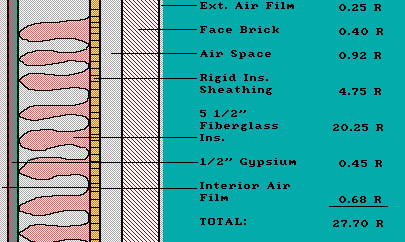

| TABLE A | |||
 |
Minimum R-values of Building Surfaces for North and South Louisiana |
||
| Surface Areas | North | South | |
| Raised floors | 11 | 0 | |
| Perimeter slab | 8 | 6 | |
| Walls | 19 | 19 | |
| Fenestration | 2 | 2 | |
| Ceilings | 30 | 26 | |

| TABLE B | |
| R-values of Building Materials | |
| R-value per Inch | Material |
| 0.20 | Common Brick |
| 0.54 | 8" Hollow Clay Tile |
| 0.58 | 8" Concrete Block |
| 0.08 | Concrete |
| 0.02 | Stucco |
| 0.79 | Wood Siding |
| 1.25 | Soft Woods |
| 0.45 | 1/2" Gypsum Board |
| 1.25 | Plywood |
| 0.44 | Asphalt Shingles |
| 0.33 | 3/8" Built-up Roof |
| 0.05 | 1/2" Slate |
| 0.94 | Wood Shingles |
| TABLE C | |
| R-value of Insulation Materials | |
| R-value per Inch | Materials |
| 3.6 - 7.5 | Foams |
| 2.8 - 3.8 | Cellulose |
| 2.5 - 4.0 | Perlite |
| 2.8 - 3.7 | Rockwool |
| 3.2 - 3.5 | High Density Fiberglass |
| 2.2 - 3.2 | Fiberglass |
| 2.4 - 3.0 | Vermiculite |
Comments or questions to: TechAsmt@LA.GOV
Return to Carpentry Menu